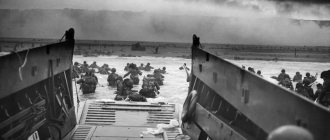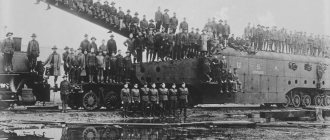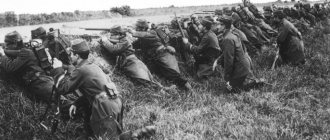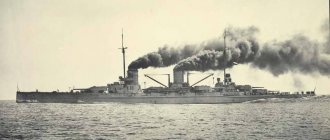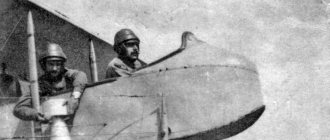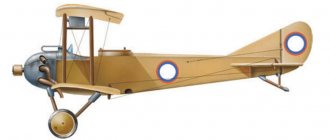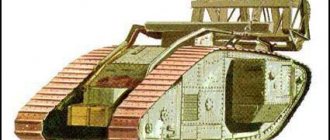Battles of 1914
The largest battle of 1914 on the Eastern Front took place in Galicia. It lasted from August to September. More than 2 million people took part in the battle. Russia lost 230 thousand killed, and Austria-Hungary 325 thousand, including prisoners.
The Russian offensive in Prussia was no less large-scale. The Battle of Tanenberg took place from August 26 to 30 between the Russian 2nd Army and German troops. The troops of Paul von Hindenburg, despite the bravery of the Russian soldiers, completely defeated the advancing Russian units of General Samsonov, who could not accept this defeat and committed suicide.
Rice. 1. General Samsonov.
At this time, on the Western Front, France almost capitulated to the advancing German troops. Already in September they could have occupied Paris, but the British arrived in time and staged a general battle on the Marne River. The battle was extended over 130 km, it was not possible to identify a clear winner and the parties switched to waging “trench” warfare.
Bombing of Papeete
After the outbreak of World War I, the German East Asia Cruiser Squadron moved east across the Pacific Ocean. During the long voyage, German ships tried to cause damage to enemy countries. For example, on September 7, the Nuremberg appeared on the Fanning Islands, destroyed an English telegraph station here, cut the transoceanic cable and disappeared.
On the night of September 13-14, the armored cruisers Scharnhorst and Gneisenau approached Apia, which had been occupied by New Zealand troops two weeks earlier, but did not find the enemy there. Then von Spee decided to change his route and visit the French Society Islands in order to fire at least one shot at the enemy on the way to America.
To deceive the coast watchers, the cruisers, departing from Samoa, headed northwest, and an intercepted radiogram from Apia confirmed that the ruse was a success. Having described a large loop in the sea, the cruisers headed east and on September 21 approached the island of Bora Bora. Raising the French flag, the Germans pretended to be French and bought fresh provisions there.
Bombing of Papeete. (diletant.media)
In Tahiti, the French had only a coastal battery of 4 65 mm guns, which, in principle, could not cause harm to a warship that could simply sail from Europe to Tahiti. After the visit of the German squadron to Apia, the French authorities, just in case, notified all their colonies in the South Pacific about the potential danger, and the battery was put on alert.
On September 22, German armored cruisers approached Tahiti. The Germans would have preferred to receive coal and provisions without a fight, but the French, seeing the enemy, opened fire. The Germans responded with fire from main caliber guns (210 mm). Panic began in Papeete. Approaching closer to the shore, the Scharnhorst noticed a large steamer and the old gunboat Seele in the harbor. French sources claim that during the battle the crew themselves sank the Zele on the entrance fairway, German sources claim that the gunboat, having received several hits, capsized and sank in the harbor. The French themselves set fire to the coal warehouses, and when a couple of German shells hit, the copra warehouses caught fire. The German cruisers moved away from Tahiti, leaving behind columns of black smoke on the shore.
The raid on Tahiti helped the German sailors regain their confidence, but reduced their supply of ammunition, which could not be replenished. The British command, having received information about German actions, realized that the enemy was moving towards America, and sent ships to intercept, which led to the Battle of Coronel.
Battles of 1916
In 1915, trench warfare reached its peak. Advance 5-10 km. was considered a feat. Everything changed in 1916.
The Battle of Verdun on the Western Front became one of the bloodiest pages of the First World War. It lasted from February to December in northeastern France and was called by soldiers the "Verdun Meat Grinder" for the number of shells and mines that were fired at the positions of both sides.
The Brusilov breakthrough, which occurred on the Eastern Front, became the best military operation of the Russian command during the entire war. General Brusilov developed a plan for an attack on the Austrian positions.
Rice. 2. General Brusilov.
At night, they dug trenches and camouflaged themselves in order to approach enemy positions and launch a surprise attack. In June 1916, a large-scale offensive began, which moved the front line tens, and in some places hundreds of kilometers to the west. However, it was not possible to bring Austria-Hungary out of the war.
The main naval battle took place in the North Sea near the Jutland Peninsula between the German and British fleets in a ratio of 99 to 148 ships. The losses were significant. The Germans lost 11 ships and 3,000 crew, the British lost 14 ships and about 7,000 sailors. No one won a clear victory in this battle.
The Battle of the Somme also took place in 1916. It is notable for being the first place where tanks were used in a British attack.
Rice. 3. Tanks on the Somme River.
World War I on the seas and oceans
By the beginning of hostilities, the Entente naval forces were significantly superior to the Navy of the Union of Central States.
In terms of spatial scope, the number of participants and the intensity of the armed struggle in the continental, oceanic and maritime theaters of military operations, the First World War had no analogues in previous history.
The most intense military operations took place in the North Sea, the North Atlantic Ocean, the Mediterranean, Baltic, Black, Barents and White Seas. In addition, episodic military operations, especially in the initial period of the war, and then when single German cruisers entered the ocean, unfolded in the central and southern parts of the Atlantic Ocean, as well as in the Pacific and Indian Oceans and (during the period of unrestricted submarine warfare) off the Atlantic coast North America.
In the northern part of the Atlantic Ocean, between North America and Western Europe, there were the most important routes of maritime communications, which were of great importance for the military economy of the Atlantic countries, especially for England, whose economy was completely dependent on maritime trade. The main hub of these messages was the southwestern approaches to England.
On the coast of the Atlantic Ocean, England and its allies had an extensive basing system, while the few German cruisers stationed before the war in the Atlantic and intended to operate on sea communications in the event of war did not have such bases. In addition, counting on the short duration of the war, the outcome of which was to be decided in land battles and in the North Sea, Germany did not attach much importance to cruising operations on remote ocean communication routes. The English cruiser squadrons allocated to protect ocean communications were to operate, each in its own zone, based in Halifax, Kingston and Gibraltar, etc. In the first three to four months of the war, single German cruisers operated on maritime communications in the Atlantic, which did not achieve significant success, but diverted large British cruising forces from the main naval theater - the North Sea.
After the defeat of the German squadron in the battle of the Falkland Islands, operations on ocean communications in the Atlantic almost ceased.
In 1915-1916, single German auxiliary cruisers appeared here only periodically, breaking the English blockade in the North Sea. In the fall of 1916, the first German submarines appeared off the coast of the United States. With the entry of the United States into the war (April 1917), during the period of unrestricted submarine warfare, they expanded their area of operation to the central and western part of the North Atlantic, right up to the coast of the United States, making raids in this area in 1917-1918. up to 15 trips. However, the main area of operation for German submarines throughout the submarine war remained the western approaches to England, which included the northeast Atlantic, the Bay of Biscay, the English Channel and the Irish Sea. Here, during the period of the most intense unrestricted submarine warfare, up to 1/4 of all combat resources of the German Navy's submarine forces based in the North Sea were concentrated, and up to six million tons of merchant tonnage were sunk (during the entire war). However, the enormous forces and means of the Allies, with the presence of numerous and well-equipped bases, made it possible to successfully deploy a powerful anti-submarine defense. Transportation along the Entente's most important sea routes in the Atlantic Ocean continued, albeit with great strain and with significant losses of tonnage, throughout the war.
In the Pacific Ocean, especially with the entry of Japan into the war, the allied fleets had a developed basing system that ensured the operation of any formations of ships to protect sea communications. Germany had here its only colonial naval base, Qingdao, where in peacetime the East Asian Cruiser Squadron was based, which made up half of all the cruising forces Germany had before the war outside the waters of the mother country. Due to the overwhelming superiority of the allied fleets in the Pacific, the German command did not intend to use Qingdao as a base in wartime. The German cruiser squadron, after some minor actions in the western part of the Pacific Ocean, went to the shores of South America. Here, at Coronel, the only naval battle of the war in the Pacific took place between German and British cruiser squadrons. After this, only in 1917, two German auxiliary cruisers operated on sea communications in the Pacific Ocean for quite a long time. At this time there were mine laying off the coast of New Zealand and Australia. These actions, due to the relatively small military significance of the Pacific communications, were primarily of a demonstrative nature and were intended to divert part of the forces of the allied fleets from the main theater of military operations - the Atlantic Ocean and the North Sea.
The Indian Ocean, to the shores of which the vast colonial possessions of England overlooked, was considered, in relation to the basing system, an “English lake”. The well-equipped ports of Cape Town, Aden, Bombay, Colombo, and Singapore provided the basing of all the forces necessary to protect maritime communications against the occasional single German cruisers operating here. In the initial period of the war, there were two German light cruisers in the Indian Ocean, against which the Entente, given the length and scattered nature of ocean communications, had to allocate quite significant forces. After the destruction of these cruisers, transportation across the Indian Ocean, which was of serious importance for the economy of England, was carried out unhindered. In 1917, during a period of particularly intense German submarine activity in the Mediterranean, the important sea route leading from the Indian Ocean through the Suez Canal and the Mediterranean Sea was temporarily (and not for all ships) moved and passed around the southern tip of Africa. At the same time, a German auxiliary cruiser operated on sea communications in the Indian Ocean, which laid mines off the southern coast of Africa and off Ceylon.
The most important sea routes passed through the English Channel, as well as along the east coast of England and to the shores of Norway.
Almost all of Germany's foreign maritime trade was carried out through this sea. With the closure of trade routes along the North Sea, Germany was left with the possibility of importing only from the Scandinavian countries through the Baltic Sea and its strait zone. Sea communications from the North Sea were also of significant importance for England. This route brought in food and timber from the Scandinavian countries, Swedish iron ore, and exported coal.
The main composition of the fleets of the strongest naval powers - England and Germany - was concentrated in the bases of the North Sea.
Table 1
Composition of naval forces in the North Sea at the beginning of the war
The main naval base of the German fleet, Wilhelmshaven, had sufficient repair facilities for ships of all classes and supplies. At the same time, approaches from the sea were covered by the island fortress of Helgoland, which in turn was a base for light forces and hydroaviation.
A body of water protected by the fortifications of Heligoland, o. [Borkum] and adjacent to the mouths of the Weser and Elbe, was called the German Bight or the “wet triangle”. In preparation for war, the German command paid great attention to the defense of this area. Coastal batteries were installed here, and barriers were placed on the approaches to the base. During the war, the German fleet was expanded to include submarine bases in the Belgian ports of Bruges, Zeebrugge and Ostend.
It should be noted that the pre-war basing of the English fleet did not meet the task assigned to it of a long-range blockade of Germany and clearly lagged behind the construction of the fleet itself.
The lack of well-equipped bases in the northern part of the sea put the Grand Fleet in a difficult position at the beginning of the war, and only the presence of convenient sheltered anchorages allowed the fleet to be in this part of the sea. Before the war, the main base of the English fleet was Portsmouth, the fleet base was Plymouth (Devonport). These bases were fortified from the sea and had docks, repair facilities and supplies.
The bases were Dover and Portland. On the southeast coast of England (the mouth of the Thames) there was a naval area called Nore with the bases of Chatham and Sheerness. On the east coast of England, in the depths of the Firth of Forth, the Rosyth base was established, and construction of the Cromarty base began in the Moray Firth. However, the location of all these peacetime bases did not meet the main tasks facing the British fleet, to establish a long-range blockade of Germany and to prevent the enemy from weakening the forces of the English fleet through the actions of mine flotillas and submarines. Therefore, immediately before the start of the war, the main forces of the English fleet were transferred to the vast sheltered bay of the Orkney Islands - Scapa Flow.
At the beginning of the war on the west coast of Scotland, Lough Ewe Bay and Lough na Keel Bay were temporarily used as basing points (until Scapa Flow was installed). In the Shetland Islands, the port of Lerwick (Lerwick) was used to base light forces that had been supporting Scandinavian convoys since 1917.
An important boundary separating England from the continent was the English Channel (English Channel) - a junction of the most important sea routes. All freight and military transport from England to France was carried out through the canal and the route from the Atlantic to the eastern ports of England passed through. At the same time, the English Channel with the Strait of Dover was the shortest route for German submarines to reach the western sea routes of England.
The main naval base of the French fleet, Brest, and the Cherbourg base were also located on the coast of the English Channel. Due to the fact that the main forces of the fleet operated in the Mediterranean Sea, these bases were of secondary importance
A developed network of water aerodromes was created on the east coast of England, and coastal batteries were installed to protect the immediate approaches to the ports.
Throughout the war, the North Sea remained the basing area for the main forces of the navies of England and Germany. Together with the northeastern part of the Atlantic Ocean, the English Channel and the approaches to it from the west, it was the most important of the naval theaters of military operations, although decisive military clashes did not occur between the fleets concentrated here.
During the First World War, the Mediterranean theater of military operations occupied an important strategic position, where sea routes to Europe from India and the Far East, as well as sea communications between France and Italy and their North African colonies, took place.
With Italy's entry into the war, superiority in forces in the Mediterranean was on the side of the Entente. England could not allocate significant forces for operations in the Mediterranean. However, the main forces of the French fleet were concentrated here, which made it possible to block the Austrian fleet in the Adriatic Sea.
table 2
Battleships
Considering the problem of basing fleets, it should be noted that the main naval base of the English fleet in the Mediterranean Sea was La Valletta on the island of Malta, which was well fortified. The fleet's base was Gibraltar, and its temporary base was Alexandria.
Assessing the system of basing the English fleet in the Mediterranean as a whole, it should be recognized that it ensured its combat activities, but during the Dardanelles operation the absence of bases in the Aegean Sea area affected it.
The main naval base of the French fleet was Toulon. At the same time, the base had all the ship repair facilities and large reserves of material and technical equipment. Bizerte served as a base for all classes of ships, Algiers was used mainly for basing destroyers, and Oran was the base point.
The existing basing system generally ensured the operations of the French fleet in the western part of the Mediterranean Sea. For operations in the Adriatic Sea, the French fleet was based at La Valletta.
The main base of the Italian fleet in the Mediterranean Sea was La Spezia. At the same time, Taranto was the main base of the Italian fleet on the Adriatic Sea. Naples was also used as a fleet base. Ports on the east coast of Italy: Brindisi, Ancona, Venice served as temporary bases.
As for the basing systems of the Italian fleet, it ensured combat operations in the middle part of the Mediterranean Sea, but was underdeveloped in the Adriatic Sea.
The system of basing the Austro-Hungarian fleet in the Mediterranean is of particular interest. its main naval base, Pola, had sheltered parking for ships of all classes, several docks and repair shops. The base point with limited repair facilities was Kotor. The close proximity to the Montenegrin border allowed until 1916 the possibility of shelling this base with artillery. From the sea, the approaches to the Bay of Kotor were protected by coastal artillery. During the war, the equipment at the Kotor base was improved. Most of the German submarines operating in the Mediterranean were based here.
By the beginning of the war, the German ships Goeben and Breslau, which were in the Mediterranean Sea, passed through the straits to Constantinople and continued to operate in the Black Sea during the war.
During the entire war there were no major operations or combat engagements of surface forces in the Mediterranean. At the same time, the activities of German submarines on the sea communications of the Entente gained the greatest development. Moreover, in three years, from the autumn of 1915, about 4 million tons of merchant tonnage were sunk here, i.e. 1/3 of all merchant tonnage sunk by German submarines in 1915-1918. Throughout the war, the Entente carried out large troop transports across the Mediterranean Sea to the Western European and Balkan theaters of military operations.
With the outbreak of the First World War, the ports of the Baltic and Black Seas found themselves cut off from the ocean, and acquired particular importance as the only route of communication between Russia and the allies (except for the route through the Pacific Ocean and Siberia), the Northern Russian naval theater of military operations.
As is known, the Barents and White Seas, due to harsh climatic conditions in winter, are largely covered with floating ice. At this time, only the Barents Sea off the western part of the Kola coast does not freeze and is available for navigation all year round.
It should be emphasized that the plans of Russian soldiers did not include military operations in the Northern Theater. The Barents and White Seas had only some commercial significance. The White Sea ports were used to export timber. There were no ports on the ice-free coast of the Barents Sea. Only Arkhangelsk was connected to the center of the country by railway. From a military point of view, the theater of operations was not equipped; there were no defensive structures. All monitoring of the coast was carried out by the messenger ship “Bakan”, which came annually from the Baltic Sea to protect the fisheries.
The current situation required the rapid development of equipment at existing ports and the creation of new ones, as well as the deployment of measures to protect maritime communications. It was necessary, first of all, to build a railway to the coast of the ice-free Kola Bay, and to use icebreakers to extend navigation on the White Sea. The first measures to equip the theater boiled down to the construction of observation posts on the approaches to Arkhangelsk. Coastal batteries were installed on Mudyugsky Island and a patrol service was organized. In January 1915, the laying of an underwater telegraph cable from England to Aleksandrovsk was completed. At the same time, a battery and booms were installed to protect the cable exit near Aleksandrovsk. A radio station and several observation posts were also built here.
Throughout the war, the Baltic naval theater of operations was important for Russia, from where an enemy with a strong fleet could threaten the entire Russian Baltic coast, including the St. Petersburg area. In addition, the northern flank of the Russian-German front abutted the sea.
Difficult navigational and hydrometeorological conditions and prolonged ice cover made it difficult to conduct combat operations and limited the use of naval forces. At the same time, the small size of the sea made it possible to deploy forces for operations in a relatively short time, and also facilitated the interaction of different classes of ships.
The Gulf of Finland, on the eastern coast of which the Russian capital was located, was of great strategic importance. Kronstadt was the mainstay of the bay's naval defense and the fleet's main repair base before the war, but basing on Kronstadt was difficult due to prolonged freeze-up. Of particular importance for the defense of the Gulf of Finland were the bottleneck of the bay between the island of Nargen and the Porkkala-Udd peninsula, as well as the Abo-Aland and Moonsund areas, which occupied a flank position at the entrance to the gulf and provided access for the fleet to operate on the open sea. The Abo-Alandek skerry area was used for basing light forces, and the Moonsund area, which at the beginning of the war did not have any means for basing and defense, covered the entrance to the Gulf of Riga.
The main base of the Russian fleet on the Baltic Sea was Helsingfors with a roadstead and the Sveaborg fortress. However, Helsingfors was not sufficiently fortified and equipped to host a fleet. The inner roadstead was inconvenient for large ships, so the battleships were forced to stand in the unprotected outer roadstead. As for ship repair facilities, they were insignificant: the only dry dock for battleships on the Baltic Sea was located in Kronstadt. Revel also had limited repair capabilities: the planned construction and equipment of the main, well-defended base of the Baltic Fleet (Peter the Great Fortress) was just begun before the war.
The Baltic Port, Rogonyul (since 1915) and Ust-Dvinsk were used as bases for the light forces of the Russian fleet. The anchorages were the roadsteads of Porkkala-Uddsky [Lapvik], Örö, Utö, Werder [Kuivast].
The forward bases and strongholds of Libau and Vindava, according to the plan, were abandoned by the Russian fleet at the beginning of the war, and in 1915 they were occupied by the enemy.
For Germany, the importance of the Baltic Theater increased due to the fact that, in the presence of an almost circular blockade, the Baltic Sea with its strait zone remained the only route for transporting iron ore and other raw materials from Sweden, which Germany urgently needed.
The German fleet had an extensive basing system in the Baltic Sea with sufficient repair facilities. The main base was Kiel. Thanks to the presence of the Kiel Canal, this base as a repair and logistics base was of great importance for the North Sea. Danzig with the well-covered Putzig roadstead, Pillau base, and from mid-1915 Libau were used as bases. It should be emphasized that the balance of standing fleet forces in the Baltic Sea was in favor of the Russian fleet.
Table 3
Composition of naval forces in the Baltic Sea at the beginning of the war
However, the German command had the opportunity, if necessary, to transfer significant forces of the High Seas Fleet through the Kiel Canal and thus create a large superiority in forces. Thus, in 1915, ships were transferred from the North Sea for a breakthrough into the Gulf of Riga, and in 1917 - for the Moonsund operation.
Taking into account the possibility of quickly concentrating the main forces of the German fleet in the Baltic Sea, the Russian command proceeded from the general balance of forces of the fleets and set defensive tasks for its fleet, the most important of which was the defense of the coast and covering the approaches to the capital from the sea.
It should be noted that the equipment of the Baltic Theater at the beginning of the war was insufficient and clearly did not meet the tasks assigned to the Russian fleet.
The basis of the defense of the Gulf of Finland at the beginning of the war was the Central Mine and Artillery Position - a minefield placed in the narrowness of the gulf and covered on the flanks by batteries on the sharp Nargen and at Porkkala Udda. Directly adjacent to it was a flank-skerry position west of Porkkala Udda, where mines were laid and batteries were installed in the first days of the war. The coastal defense of the Central Position did not provide strong cover for the flanks. The defense of the position was entrusted to the fleet, the main forces of which were deployed in the rear of the position in anticipation of a battle with the German fleet during its breakthrough into the Gulf of Finland.
The deployment of inactive operations in the middle and southern parts of the sea in 1914 required strengthening of the theater equipment in order to ensure the defense of the Gulf of Finland. Batteries were built in the areas of the islands of Nargen and Revel, two batteries on the island of Worms and a battery on the Porkkala-Udd peninsula.
To expand the basing of light forces and submarines in the areas of the Abo-Aland skerries and the Moonsund archipelago, intensive work began at the end of 1914, which continued in subsequent years.
Assessing the state of the defense of the German coast at the beginning of the war, it should be considered stable. During the war, a wide network of airfields, radio stations and direction-finding stations was created on the coast. Defensive minefields were placed mainly in the strait zone and on the approaches to their bases, active minefields were placed in the northern part of the Baltic Sea in order to block the Russian fleet in the Gulf of Finland.
Moving on to the consideration of the Black Sea theater of military operations, it should be noted that if more or less sufficient attention was paid to the equipment of the Baltic naval theater of military operations (TVD) before the First World War, the same cannot be said about the Black Sea theater of operations. The attitude of Russia's top military leadership towards the latter, as a secondary theater of military operations, negatively affected not only the construction of ships, but also the organization of the basing system.
Meanwhile, the limited size of the Black Sea, and therefore the relatively short distances to the enemy’s most important targets (280 miles from Sevastopol to the Bosphorus) made it possible to quickly deploy forces in any area.
The main base of the Black Sea Fleet was Sevastopol, the base points were Odessa and Batum, and the rear repair base was Nikolaev. At the same time, only the main fleet base was relatively equipped. However, Sevastopol was weakly fortified from the sea. Therefore, the safety of the ships located in Sevastopol in wartime was not guaranteed. The port itself was also insufficiently equipped. The remaining bases were in extremely unsatisfactory condition. The Military Department, to which they were subordinate until 1910, repeatedly demanded the elimination of fortifications in Batumi (Batumi) and Ochakovo, and only the decisive action of the Navy Ministry against such a rash decision made it possible to preserve them as possible bases for the fleet during the war.
Batum was important not only as a naval base, but also as a transport and transshipment point for supplying the Caucasian army. Enhanced defensive work to strengthen Batum began only during the war. Coastal defenses were reinforced with field guns, an observation post, and minefields on the approaches to the port. A hydroaviation base was equipped, and the fortress artillery of Batum, which had insufficient firing range, received new guns for reinforcement at the end of 1914.
In addition to the listed fortified points, coastal batteries were installed near Odessa, on the Tendra Spit, at Ak-Mosque, Yevpatoria, Yalta, Feodosia, Novorossiysk, Tuapse, Sochi, Gagra, Sukhumi, Poti.
By the beginning of the war, there were several radio stations in Russia, and a number of new stations were built during the war.
The network of observation and communication posts was widely developed; all coastal points were interconnected by telegraph and telephone communications. The airfield network was developed.
The most serious drawback of the system of basing fleet forces on the Black Sea theater of operations was the lack of a well-equipped and protected naval base on the Caucasus coast.
The main enemy of Russia in the Black Sea theater of operations was Türkiye.
By the beginning of the war, Turkey had the only naval base in the theater of operations - Constantinople, and since 1915, when Bulgaria took the side of the Central Powers, Varna was used for temporary basing (in particular, by submarines).
Sea connections on the Black Sea were of great importance for Turkey, since the road network on the Anatolian coast was very poorly developed. Its most important internal sea route ran along the Anatolian coast from Constantinople to Trebizond. This route supplied the armies of the Caucasian Front, and also delivered coal from the Zonguldak and Eregli region to the capital. The lack of convenient anchorages protected from the sea made it difficult for the Turks to organize the protection of sea communications. During the war, this path underwent some changes compared to peacetime. At the same time, the ships moved closer to the shore at relatively shallow depths, which significantly complicated the actions of Russian submarines.
Table 4
The composition of the naval forces on the Black Sea at the beginning of the war with Turkey
By the beginning of the war, there were no new battleships in the Black Sea Fleet (3 dreadnoughts were built in Nikolaev), however, Russian battleships were stronger than Turkish ones. However, the arrival of the German battle cruiser Goeben from the Mediterranean Sea to Constantinople in August 1914 negated the advantage of the Russian fleet.
The fact is that the high-speed Goeben, like the German light cruiser Breslau, could escape from any formation of Russian ships superior in strength and, in turn, had the opportunity to impose battle on the weaker of the enemy ships.
A few words should be said about the Black Sea straits of the Bosporus and Dardanelles, connecting the Black and Mediterranean Seas through the Sea of Marmara. The Bosphorus Strait is 16 miles long and up to two miles wide; depths along the axis of the strait are 28-100 m. Both banks at the entrance to the strait from the Black Sea were heavily fortified by the beginning of the war.
On the Asian shore of the strait from the entrance from the Black Sea there were eight forts and coastal batteries - in total up to 50 guns of caliber from 150 to 80 mm; there are also eight forts and batteries on the European coast - in total over 20 guns of caliber from 150 to 350 mm.
The mine defense of the Bosphorus was organized even before the start of the war. Three rows of mines controlled from the shore were placed across the strait in the narrow area between Rumeli-Kavak and Agadolu-Kvvak. At the same time, the passage was left on the eastern side. Several rows of mines were laid north of Anadolu-Kavak, and several individual mine banks were laid along the Asian coast. Directly at the entrance, a barrier was placed across the strait. Mines were also placed near Killos.
The length of the Dardanelles Strait is 35 miles, the width is two to three miles, the depth along the axis of the strait is 50 - 100 m; the narrowness at Çanakkale is eight cables wide.
The fortifications of the Dardanelles consisted of a number of batteries, which were located near the coast and were divided into external and internal. Intermediate batteries located at heights had guns (mostly field guns and mortars) with a caliber of no more than 150 mm.
By the beginning of hostilities, the defense of the strait included a number of old open forts built in 1877-1878, armed with outdated cannons, and several batteries. The firing range of the guns did not exceed nine km. The total number of guns reached 100. During the war, the equipment was updated and expanded, especially in connection with the Dardanelles landing operation of the Anglo-French fleet.
When approaching the strait from the Aegean Sea, enemy ships first of all fell into the fire zone of the forts and external batteries of Kumkale and Seddulbahir, installed at the very entrance to the strait. These forts and batteries were armed with 26 guns, including 16 of 240-280 mm caliber.
Approaching the beam of the Seddyulbahir batteries, the ships came out from under fire from the Kumkale battery, but remained in the fire zone of the batteries and the Seddyulbahir fort. This system of gun placement made it possible to fire both across and along the strait, to the stern of ships breaking through into the strait.
Further along the Asian and European coasts there were intermediate batteries (85 guns of 120 - 210 mm caliber. Among them was the Dardanos battery on a high hill on the Asian coast near the Kepez-Limany Bay, which fired at the strait in both directions at the maximum firing range.
The basis of the strait's defense was strong internal batteries located on both sides of the narrow part of the strait up to Çanakkale. On the Asian coast there were coastal batteries Hamidiye I and Chimenlik, on the European coast - Rumeli, Hamidiye II, Namazgah. In addition, north of Çanakkale on the Asian coast, up to the Nagra narrowness, there were three forts, which were also part of the general defense system of the narrow strait.
All internal forts and batteries had 88 guns, including 12 guns of 280 - 355 mm caliber, 57 guns from 210 to 260 mm. The batteries of the newest construction were especially strongly fortified - Hamidiye I on the Asian coast and opposite Hamidiye II on the European coast. The fire control of the batteries, as well as the entire management of the naval defense of the strait, was carried out by German officers.
Assessing the balance of forces at sea at the beginning of the First World War, it should be noted that the combined naval forces of the Entente (England, France and Russia) significantly exceeded the naval forces of the Union of Central States both in general, there and in most naval theaters of war.
Taking into account the ships that were under construction, the fleets of the Entente states were twice as superior to the navies of Germany and its allies in new battleships, 2.5 times in battlecruisers, 2.5 times in destroyers, and 2.5 times in submarines - three times.
In addition, the Entente fleets had a more developed basing system and a better strategic position in most naval theaters of war.
Battle of 1917
The most significant battle of the penultimate year of the war was Operation Nivelle. Britain and France were preparing an offensive to turn the tide of the war. On the Western Front, huge forces were assembled in the areas of the offensive, superior to the Germans, however, it was not possible to break through the front line. The Entente lost more than 340 thousand people, and the Germans more than 160 thousand.
In Russia, by 1917, complex political processes took place within the country, which finally brought it out of the war and a lull arose on the Eastern Front.
Fischer is not crazy
Admiral Sir John Arbuthnot Fisher, First Sea Lord of Britain in 1904-1910, was an unpleasant person, but he had a completely lethal combination of intelligence, will, efficiency, wild imagination, a sharp tongue and that quality of nature, which in modern slang is called “frostbite.” Fischer said at every corner that the problem of the growing German fleet must be solved in the only way - to destroy it with a surprise attack at the base, for which he eventually received the highest resolution from King Edward VII: “God, Fischer, you must be crazy?!”
It is not surprising that this man became one of the largest reformers of the Royal Navy - he managed to bend the “state-forming” corporation, whose inertia, served under the sauce of following traditions, had already become a joke by that time. “I don’t advise you to interfere with me,” he snapped, meeting resistance from the admirals. “I will crush anyone who dares to stand in my way.”
Captain John Arbuthnot Fisher, 1883.
The photo is not exactly from that era, but it perfectly conveys the character.
Fisher’s merits in freeing the fleet from old ships, restructuring the officer training and basing system can be listed for a long time, but today we are interested in only one: the construction of the battleship Dreadnought, which launched the naval “dreadnought” race in the world.
By the early 1900s, a “de facto standard” for battleships had emerged in the world: a combat unit with a displacement of 14-16 thousand tons with a full speed of about 18 knots and an armament of four 305-mm guns and 12-18 medium-caliber guns ( usually 12-14 six-inch).
The development of heavy artillery ships had actually reached a dead end: further it was possible to either increase the displacement, or roll back to a smaller main caliber (203-254 millimeters), increasing the number of guns. For some time, hopes were pinned on combinations of large 305 mm and intermediate calibers (for example, 234 mm on the British battleships of the King Edward VII and Lord Nelson types, 240 on the French Dantons, or 203 on the Russian Andrey First-Called” and “Eustathia”), but this option also did not work.
The main reason for abandoning this decision was the insignificant power of such projectiles in comparison with heavy ones. There is a rough rule according to which the weight, and therefore the effectiveness of armor-piercing shells, can be estimated through the ratio of caliber cubes. As a result, the efficiency of the fire dropped significantly, and the installations still took a disproportionate amount of the top weight. In addition, combat distances grew, and at them the accuracy of heavy projectiles was higher.
Table of major battles of the First World War
| Battle | date | Participants | |
| On the Marne | September 1914 | Britain, France | Germany |
| Under Tanenberg | 21-25.08.1914 | Russia | Germany |
| In Gallicia | August-September 1914 | Russia | Austria-Hungary |
| At Verdun | February-December 1916 | Britain, France | Germany |
| Brusilovsky breakthrough | June-November 1916 | Russia | Austria-Hungary |
| Jutland naval operation | May 31 – June 1, 1916 | Britannia | Germany |
| Operation Nivelle | April–May 1917 | Entente | Germany |
Second Battle of the Marne
German soldiers between the Loivre and Brimont, near the Marne River, 1918. Photo:. Date: July 15 - August 6, 1918 France, Great Britain, USA and Italy against the German Empire The destructive battles of 1915-1916 brought some opponents to the brink of revolution and collapse, while weakening others to the point of exhaustion. The year 1917 was mainly spent in a positional struggle, which the enemies waged with varying success and small forces. The final year of military confrontation required decisive action, and the Germans were the first to attack. Unfortunately for you. Because the one and a half million corps of commander Erich Ludendorff was opposed by the united front of France, Great Britain, Italy and the United States, which gathered more than a million soldiers for the second Battle of the Marne. Ludendorff launched the attack on July 15, 1918, but the breakthrough was stopped two days later. And a day later, the allies launched a counter-offensive and pushed their opponents back to their previous positions. At the Marne, Germany exhausted its military potential and, by and large, lost the war. A series of subsequent defeats in small battles finally brought the Germans to Compiegne, where on November 18, 1918, the enemies, who had been killing each other for four years, signed a truce, summing up the disappointing outcome of WWII.
Map of the Western Front for 1918. Photo: Public domain.
Operation Dardanelles
Another major naval battle, stretched over the whole of 1915. The campaign included the capture of the straits and the landing of Anglo-French troops. But the First World War was characterized by unforeseen situations. Major battles did not always go according to the plan, and sometimes operations failed. This is what happened with the strategic plan called the Dardanelles. The parties suffered colossal losses: almost 200 thousand soldiers were injured in the Turkish army, and 150 thousand among the allies. These are the wounded and killed, as well as the missing.
In May, Italy joined the Entente. At the same time, German submarines were able to penetrate the Mediterranean. They managed to sink 100 merchant ships, while simultaneously losing only one piece of equipment. Thus, despite Italian assistance, the Allies were unable to achieve superiority in the 1915 naval campaign. The only positive was the evacuation of the Serbian army, which was defeated by enemy forces in the fall.
Kerensky's offensive
In 1917, the Bolsheviks overthrew the monarchy, and therefore the further course of the war was dictated by revolutionary events in the country. The Russians began their offensive in June 1917, but after two days of active advance they suddenly stopped. The soldiers considered that this was enough; they had completely fulfilled their sacred duty.
Newcomers also refused to take the front row. All this disorder and general disobedience occurred against the backdrop of regular desertion that the revolution provoked. The major battles of World War I had never seen such widespread chaos and panic among the military personnel.
At this time, taking advantage of the situation, Germany attacked and pushed the Russian units back to their old positions. The once strong and courageous Russian army has virtually ceased to exist as an organized force. Germany was no longer afraid of its enemy and was able to strengthen itself on all fronts. The Russians had to conclude the Brest-Litovsk Peace Treaty, which was unprofitable and humiliating for our country.
Brusilovsky breakthrough
The main battles of World War 1 were not without the courage and strategic skills of General Brusilov. In the summer of 2016, under his leadership, the Russians broke through on the Southwestern Front. The Austro-Hungarian army lost many soldiers and officers. The figure is astonishing - 1.5 million killed.
The Russians occupied Bukovina and Galicia. This forced the Germans to strengthen their positions here by transferring additional forces from the Western Front to this area. Despite this, Russia's allies strengthened in this territory, the Entente was also completed by Romania, which went over to the side of the Union.
Russian troops were also missing many valiant heroes. And therefore, a new wave of mobilization was announced in the country, calling on newcomers to join the thinning ranks of the army. This unpopular step by the government caused outrage and discontent among the common people. People did not want to be “cannon fodder,” because the First World War spared neither the old nor the young. The main battles show that there were many losses both on the part of the Russians and on the part of their opponents.
Sarykamysh battle
Speaking about the main battles of the Great Patriotic War (that’s what it was called before the start of World War II), one cannot fail to mention this operation. Russia and Turkey competed in it on the threshold of the new year 1915. At that time, the Turkish command was developing a cunning plan: to capture Karas and completely destroy the army of the Caucasus.
The Crescent Forces advanced. The Russians were surrounded in Sarykamysh, but they continued to pin down the main forces of the enemy and impede their advance. Accustomed to a milder climate, their opponents could not withstand the harsh winter. Tens of thousands of Turkish soldiers died from severe frosts and snowstorms in just one day.
The Russians were waiting at this time, which was the right decision. Soon reinforcements approached Sarykamysh, and the Crescent Army was defeated. In total, about 100 thousand people died in this operation. The largest battles of the First World War also included this battle, since it played an important strategic role: the situation in the Caucasus was stabilized, and the Russians were able to curb their ardent enemy - Turkey.
